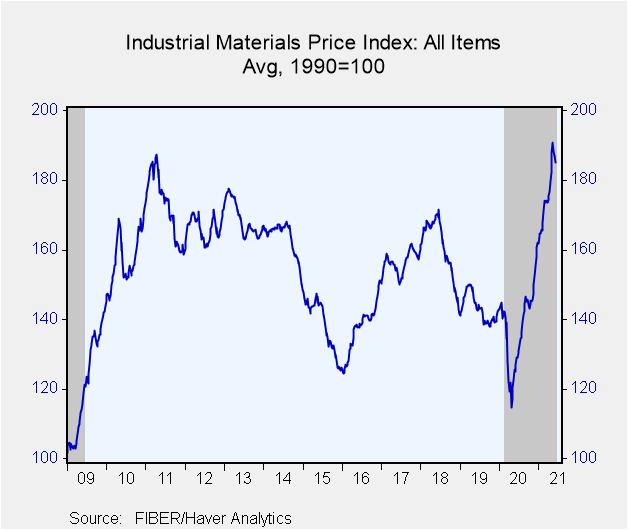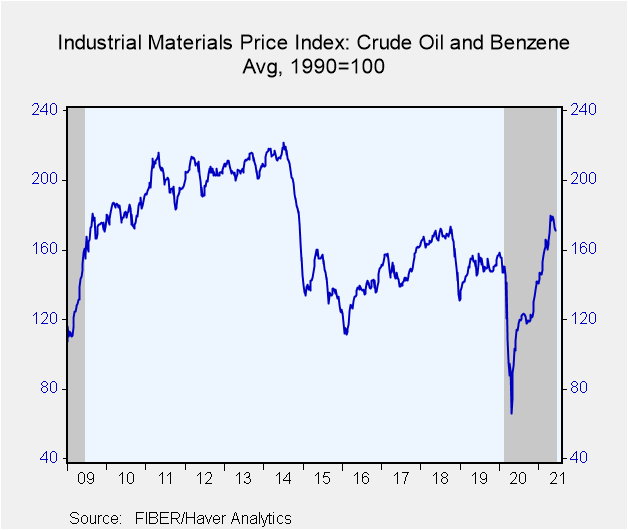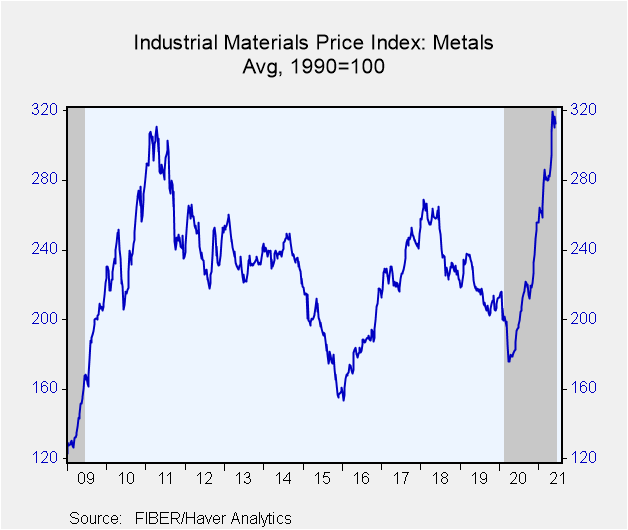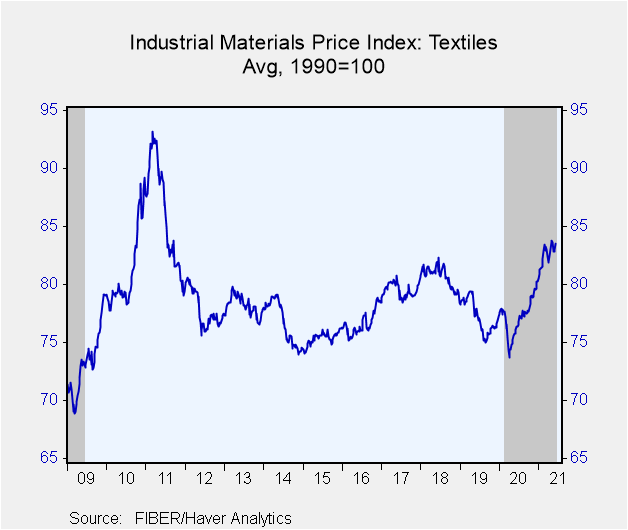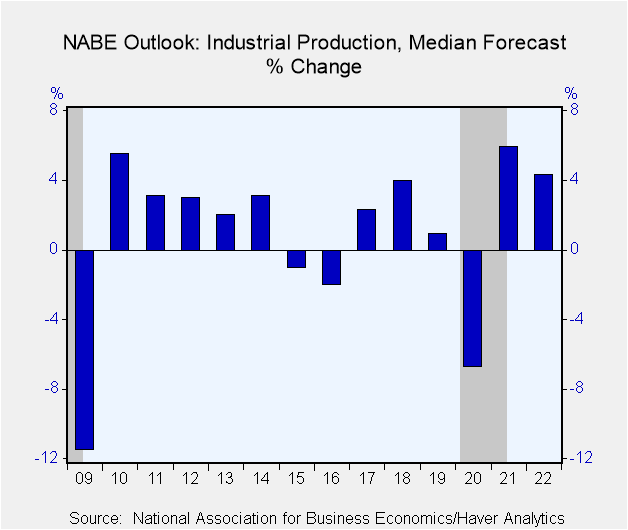 Global| Jun 14 2021
Global| Jun 14 2021FIBER: Industrial Commodity Prices Take a Breather
by:Tom Moeller
|in:Economy in Brief
Summary
• Framing lumber prices retreat after extraordinary gains. • Metals prices soften. • Prospects for prices remain good. The Industrial Materials Price Index, from the Foundation for International Business and Economic Research (FIBER), [...]
• Framing lumber prices retreat after extraordinary gains.
• Metals prices soften.
• Prospects for prices remain good.
The Industrial Materials Price Index, from the Foundation for International Business and Economic Research (FIBER), fell 3.1% during the four weeks ended June 11. On a weekly basis, prices fell 1.0%, down for the fourth straight week. Despite the declines, prices were up 43.2% y/y as manufacturing sector activity remained firm.
Prices in the miscellaneous group led the decline and fell 5.7% during the last four weeks. Framing lumber prices weakened by 26.7%, but they remained 234.2% higher y/y as home building remained strong. Plywood prices were unchanged. Natural rubber prices weakened 6.3% in the last four weeks.
Prices in the crude oil & benzene group backed off 4.6% in four weeks. Prices for the petro-chemical benzene fell by one-third but remained more than double their year-ago level. Working 7.8% higher were crude oil prices to $69.64 per barrel, up from $38.08 twelve months ago. Excluding crude oil, industrial commodity prices fell 3.7% in the last four weeks.
Metals prices also backed away from recent highs, falling 2.1% during the last four weeks. The cost of copper scrap fell 6.0% and aluminum prices were off 2.6%. Lead prices fell 1.8%, but they remained up by one-quarter y/y. Steel scrap prices eased 0.7% but zinc prices were little changed (48.2% y/y).
In the textile group, prices eased 0.1% during the last month as cotton prices weakened 2.2%. A 2.7% rise (31.9% y/y) in the cost of burlap, used for sacks, bags and gardening, offset the decline.
Forecasts from the National Association for Business Economics suggest that industrial commodity prices should remain firm. It calls for a 5.9% rise in industrial output this year, followed by a 4.3% gain in 2022.
The Foundation for International Business and Economic Research (FIBER) develops economic measurement techniques as applied to business cycles and inflation in the U.S. and other market economies. The commodity price data can be found in Haver's DAILY, WEEKLY, USECON and CMDTY databases.
| FIBER Industrial Materials Price Index (%) | 4-Week | 3-Month | 6-Month | 12-Month | 2020 | 2019 | 2018 |
|---|---|---|---|---|---|---|---|
| All Items | -3.1 | 6.4 | 17.0 | 43.2 | 13.5 | 1.1 | -12.0 |
| Excluding Crude Oil | -3.7 | 6.3 | 15.2 | 41.0 | 16.0 | -0.6 | -11.1 |
| Textiles | -0.1 | 0.7 | 4.9 | 9.3 | 3.9 | -1.6 | -2.8 |
| Cotton (cents per pound) | -2.2 | -0.3 | 19.6 | 45.4 | 11.6 | -6.6 | -9.2 |
| Metals | -2.1 | 11.6 | 24.2 | 61.4 | 20.4 | -4.3 | -12.2 |
| Aluminum ($ per metric ton) | -2.6 | 13.1 | 21.3 | 54.7 | 13.1 | -6.5 | -12.7 |
| Copper Scrap (cents per pound) | -6.0 | 9.7 | 28.1 | 72.7 | 26.9 | 3.5 | -16.1 |
| Steel Scrap ($ per ton) | -0.7 | 12.4 | 27.8 | 91.0 | 43.6 | -0.8 | 2.3 |
| Crude Oil & Benzene | -4.6 | 3.1 | 21.6 | 50.0 | -9.7 | 20.2 | -20.0 |
| Crude Oil (WTI, $ per Barrel) | 7.8 | 6.8 | 51.1 | 82.9 | -21.4 | 35.5 | -24.4 |
| Miscellaneous | -5.7 | 8.3 | 19.1 | 56.9 | 29.1 | -0.0 | -14.8 |
| Framing Lumber ($ per 1000 board ft.) | -26.7 | 21.1 | 63.9 | 234.2 | 113.5 | 22.6 | -23.1 |
| Natural Rubber (cents per pound) | -6.3 | -5.3 | -7.4 | 43.7 | 48.6 | 10.7 | -4.1 |
Tom Moeller
AuthorMore in Author Profile »Prior to joining Haver Analytics in 2000, Mr. Moeller worked as the Economist at Chancellor Capital Management from 1985 to 1999. There, he developed comprehensive economic forecasts and interpreted economic data for equity and fixed income portfolio managers. Also at Chancellor, Mr. Moeller worked as an equity analyst and was responsible for researching and rating companies in the economically sensitive automobile and housing industries for investment in Chancellor’s equity portfolio. Prior to joining Chancellor, Mr. Moeller was an Economist at Citibank from 1979 to 1984. He also analyzed pricing behavior in the metals industry for the Council on Wage and Price Stability in Washington, D.C. In 1999, Mr. Moeller received the award for most accurate forecast from the Forecasters' Club of New York. From 1990 to 1992 he was President of the New York Association for Business Economists. Mr. Moeller earned an M.B.A. in Finance from Fordham University, where he graduated in 1987. He holds a Bachelor of Arts in Economics from George Washington University.


